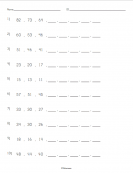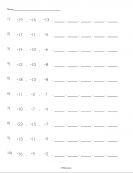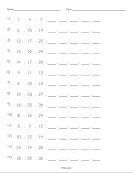Skip Counting Worksheets
Skip counting, or counting by a number other than 1, is a technique frequently used to count large numbers of items. This technique can also be applied to learning many math skills including addition, subtraction, negatives, and multiplication tables. These customizable and printable worksheets are designed to help students practice various forms of skip counting.
All of the skip counting worksheets contain problems with incomplete number sequences. The student’s goal is to identify the pattern of numbers and complete the sequence. The basic Skip Counting Worksheet is for skip count of positive numbers in an increasing order. This worksheet can be useful for practicing simple addition and identification of very basic patterns. For multiplication table practice, the Times Table Skip Counting Worksheet is useful. It only includes number patterns that align with the times tables. The Reverse Skip Counting Worksheet only includes positive numbers, but the sequences are in a reverse order. This is helpful for students to practice basic subtraction. Finally, if your student needs to practice working with negative numbers, the Skip Counting with Negatives Worksheet is what you are looking for. This worksheet includes at least one negative number in each sequence and some of the sequences will cross zero.
Reverse Skip Counting Worksheet
Skip Counting with Negatives Worksheet
Skip Counting Worksheet
Times Table Skip Counting Worksheet
ADVERTISEMENT



